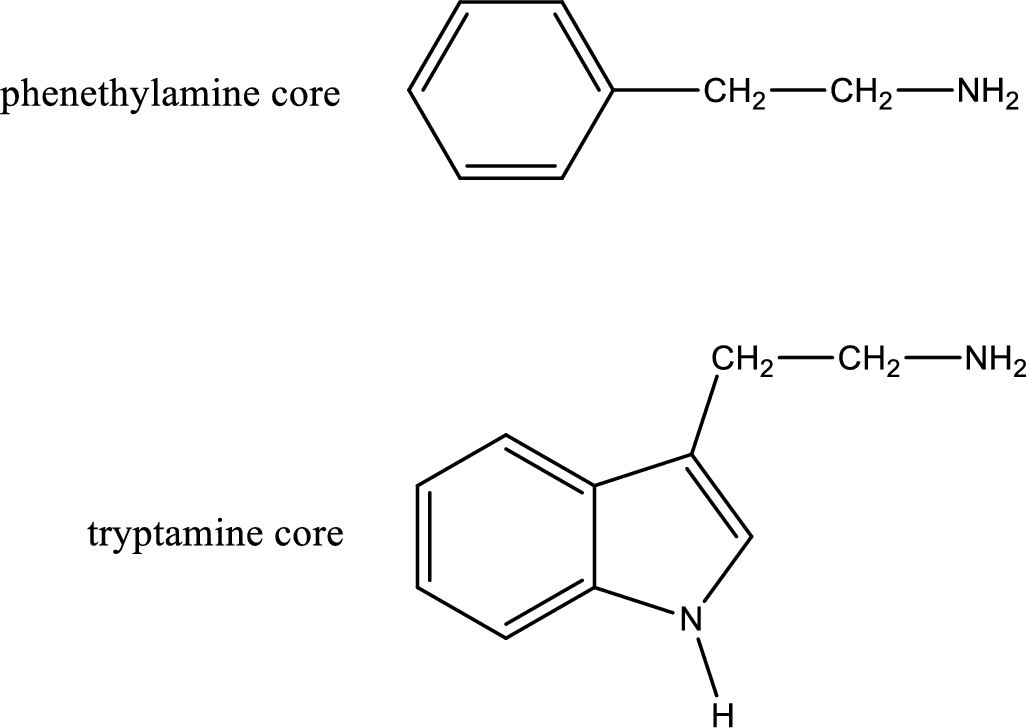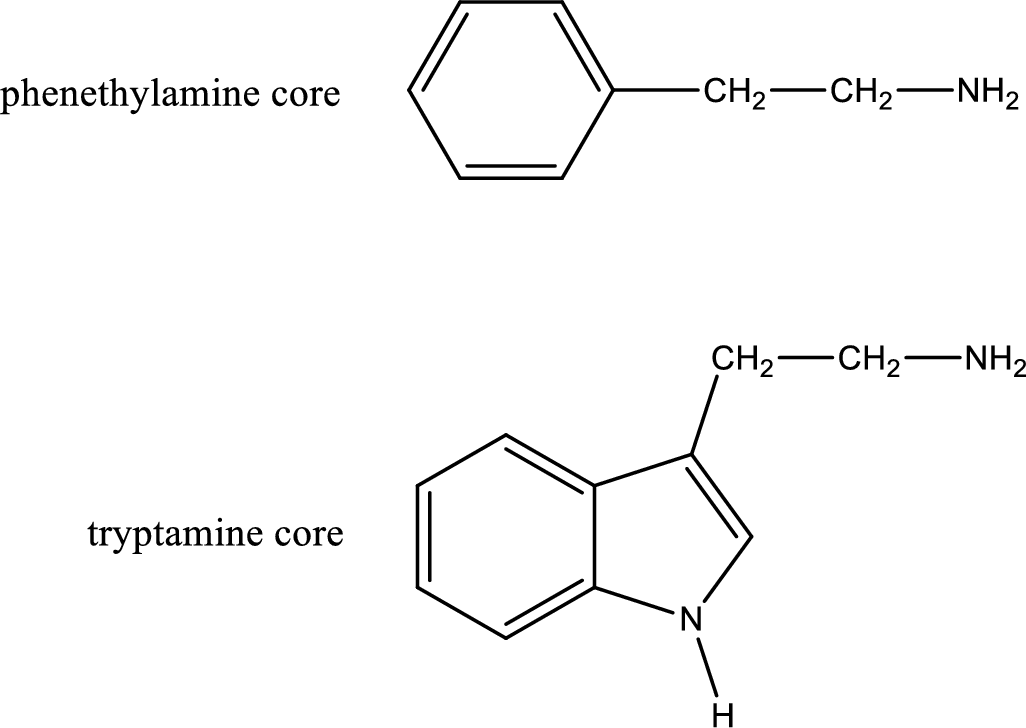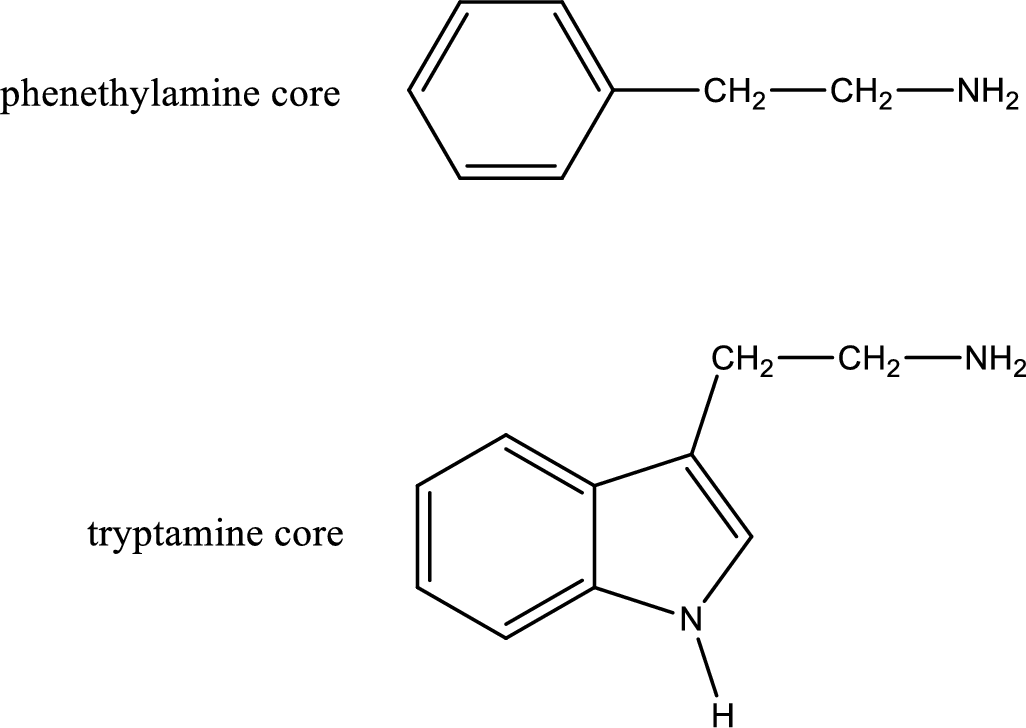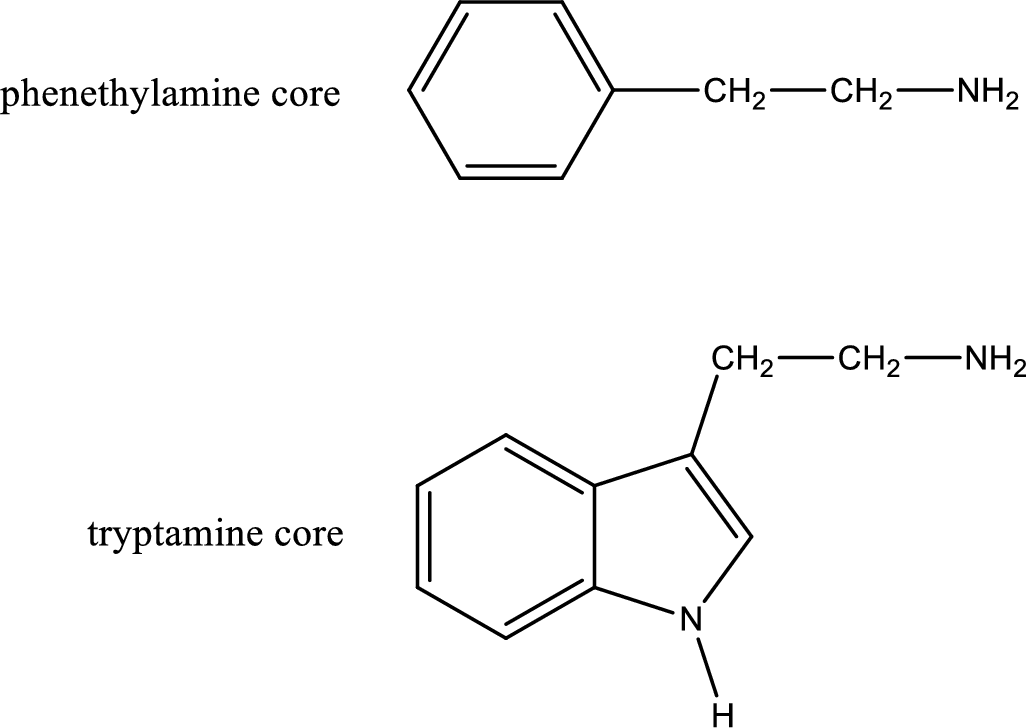
(a)
Interpretation:
Dopamine and serotonin have same tryptamine core or not has to be indicated as true or false.
Concept Introduction:
Generally

There are three types of effects that an amine can exert. They are neurotransmitters, central nervous system stimulants and decongestants. Neurotransmitters are the substances that are present in human body that help in passing impulse of nerves from one cell to another. Central nervous stimulants are the substances that help in speeding up of physical and mental processes. Decongestant is a substance that is used to relieve nasal congestion.
(b)
Interpretation:
Parkinson’s disease is due to the deficiency of dopamine has to be indicated as true or false.
Concept Introduction:
Generally amines are toxic in nature. If a compound contains only amine as its functional group, they will be often toxic. Due to this, in biological systems they are not prevalent. If the same compound contains more than one functional group apart from amine means it can be physiologically active. Important “core” structures that are frequently encountered in polyfunctional amines that have biological effects are tryptamine core and phenethylamine core.

There are three types of effects that an amine can exert. They are neurotransmitters, central nervous system stimulants and decongestants. Neurotransmitters are the substances that are present in human body that help in passing impulse of nerves from one cell to another. Central nervous stimulants are the substances that help in speeding up of physical and mental processes. Decongestant is a substance that is used to relieve nasal congestion.
(c)
Interpretation:
Epinephrine and norepinephrine differs by a methyl group only has to be indicated true or false.
Concept Introduction:
Generally amines are toxic in nature. If a compound contains only amine as its functional group, they will be often toxic. Due to this, in biological systems they are not prevalent. If the same compound contains more than one functional group apart from amine means it can be physiologically active. Important “core” structures that are frequently encountered in polyfunctional amines that have biological effects are tryptamine core and phenethylamine core.

There are three types of effects that an amine can exert. They are neurotransmitters, central nervous system stimulants and decongestants. Neurotransmitters are the substances that are present in human body that help in passing impulse of nerves from one cell to another. Central nervous stimulants are the substances that help in speeding up of physical and mental processes. Decongestant is a substance that is used to relieve nasal congestion.
(d)
Interpretation:
Epinephrine and adrenaline are the names of same compound has to be indicated as true or false.
Concept Introduction:
Generally amines are toxic in nature. If a compound contains only amine as its functional group, they will be often toxic. Due to this, in biological systems they are not prevalent. If the same compound contains more than one functional group apart from amine means it can be physiologically active. Important “core” structures that are frequently encountered in polyfunctional amines that have biological effects are tryptamine core and phenethylamine core.

There are three types of effects that an amine can exert. They are neurotransmitters, central nervous system stimulants and decongestants. Neurotransmitters are the substances that are present in human body that help in passing impulse of nerves from one cell to another. Central nervous stimulants are the substances that help in speeding up of physical and mental processes. Decongestant is a substance that is used to relieve nasal congestion.
Trending nowThis is a popular solution!

Chapter 17 Solutions
General, Organic, and Biological Chemistry
- Ch.21 What causes patients infected with the yellow fever virus to turn yellow (jaundice)? A. low blood pressure and anemia B. excess leukocytes C. alteration of skin pigments D. liver damage in final stage of disease — What is the advantage for malarial parasites to grow and replicate in red blood cells? A. able to spread quickly B. able to avoid immune detection C. low oxygen environment for growth D. cooler area of the body for growth — Which microbe does not live part of its lifecycle outside humans? A. Toxoplasma gondii B. Cytomegalovirus C. Francisella tularensis D. Plasmodium falciparum — explain your answer thoroughlyarrow_forwardCh.22 Streptococcus pneumoniae has a capsule to protect it from killing by alveolar macrophages, which kill bacteria by… A. cytokines B. antibodies C. complement D. phagocytosis — What fact about the influenza virus allows the dramatic antigenic shift that generates novel strains? A. very large size B. enveloped C. segmented genome D. over 100 genes — explain your answer thoroughlyarrow_forwardWhat is this?arrow_forward
- Molecular Biology A-C components of the question are corresponding to attached image labeled 1. D component of the question is corresponding to attached image labeled 2. For a eukaryotic mRNA, the sequences is as follows where AUGrepresents the start codon, the yellow is the Kozak sequence and (XXX) just represents any codonfor an amino acid (no stop codons here). G-cap and polyA tail are not shown A. How long is the peptide produced?B. What is the function (a sentence) of the UAA highlighted in blue?C. If the sequence highlighted in blue were changed from UAA to UAG, how would that affecttranslation? D. (1) The sequence highlighted in yellow above is moved to a new position indicated below. Howwould that affect translation? (2) How long would be the protein produced from this new mRNA? Thank youarrow_forwardMolecular Biology Question Explain why the cell doesn’t need 61 tRNAs (one for each codon). Please help. Thank youarrow_forwardMolecular Biology You discover a disease causing mutation (indicated by the arrow) that alters splicing of its mRNA. This mutation (a base substitution in the splicing sequence) eliminates a 3’ splice site resulting in the inclusion of the second intron (I2) in the final mRNA. We are going to pretend that this intron is short having only 15 nucleotides (most introns are much longer so this is just to make things simple) with the following sequence shown below in bold. The ( ) indicate the reading frames in the exons; the included intron 2 sequences are in bold. A. Would you expected this change to be harmful? ExplainB. If you were to do gene therapy to fix this problem, briefly explain what type of gene therapy youwould use to correct this. Please help. Thank youarrow_forward
- Molecular Biology Question Please help. Thank you Explain what is meant by the term “defective virus.” Explain how a defective virus is able to replicate.arrow_forwardMolecular Biology Explain why changing the codon GGG to GGA should not be harmful. Please help . Thank youarrow_forwardStage Percent Time in Hours Interphase .60 14.4 Prophase .20 4.8 Metaphase .10 2.4 Anaphase .06 1.44 Telophase .03 .72 Cytukinesis .01 .24 Can you summarize the results in the chart and explain which phases are faster and why the slower ones are slow?arrow_forward
- Can you circle a cell in the different stages of mitosis? 1.prophase 2.metaphase 3.anaphase 4.telophase 5.cytokinesisarrow_forwardWhich microbe does not live part of its lifecycle outside humans? A. Toxoplasma gondii B. Cytomegalovirus C. Francisella tularensis D. Plasmodium falciparum explain your answer thoroughly.arrow_forwardSelect all of the following that the ablation (knockout) or ectopoic expression (gain of function) of Hox can contribute to. Another set of wings in the fruit fly, duplication of fingernails, ectopic ears in mice, excess feathers in duck/quail chimeras, and homeosis of segment 2 to jaw in Hox2a mutantsarrow_forward
 Human Physiology: From Cells to Systems (MindTap ...BiologyISBN:9781285866932Author:Lauralee SherwoodPublisher:Cengage LearningEssentials of Pharmacology for Health ProfessionsNursingISBN:9781305441620Author:WOODROWPublisher:Cengage
Human Physiology: From Cells to Systems (MindTap ...BiologyISBN:9781285866932Author:Lauralee SherwoodPublisher:Cengage LearningEssentials of Pharmacology for Health ProfessionsNursingISBN:9781305441620Author:WOODROWPublisher:Cengage- Case Studies In Health Information ManagementBiologyISBN:9781337676908Author:SCHNERINGPublisher:Cengage
 Principles Of Radiographic Imaging: An Art And A ...Health & NutritionISBN:9781337711067Author:Richard R. Carlton, Arlene M. Adler, Vesna BalacPublisher:Cengage Learning
Principles Of Radiographic Imaging: An Art And A ...Health & NutritionISBN:9781337711067Author:Richard R. Carlton, Arlene M. Adler, Vesna BalacPublisher:Cengage Learning Human Heredity: Principles and Issues (MindTap Co...BiologyISBN:9781305251052Author:Michael CummingsPublisher:Cengage Learning
Human Heredity: Principles and Issues (MindTap Co...BiologyISBN:9781305251052Author:Michael CummingsPublisher:Cengage Learning





